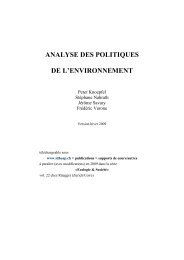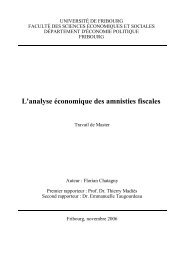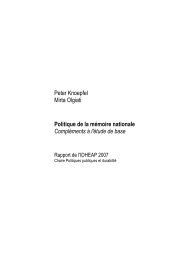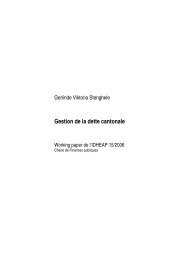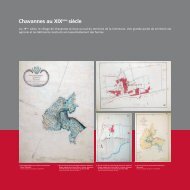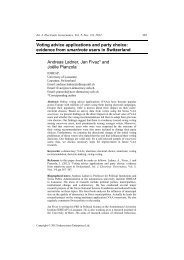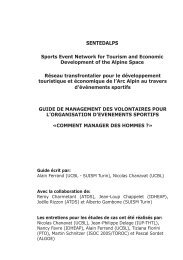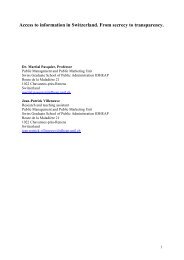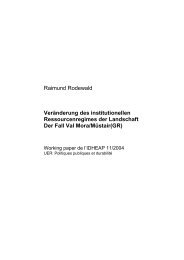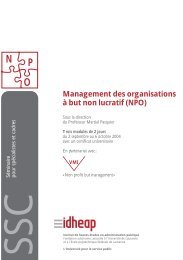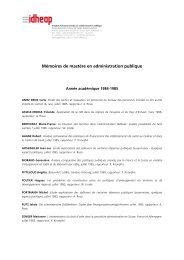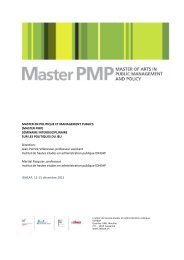Historical Analysis of Institutional Regimes in Switzerland ... - IDHEAP
Historical Analysis of Institutional Regimes in Switzerland ... - IDHEAP
Historical Analysis of Institutional Regimes in Switzerland ... - IDHEAP
You also want an ePaper? Increase the reach of your titles
YUMPU automatically turns print PDFs into web optimized ePapers that Google loves.
20<br />
should also be emphasised that the construction areas and their prices doubled between 1950 and<br />
1995. Property title is distributed as follows: 61% <strong>of</strong> agricultural zones are the property <strong>of</strong> private<br />
owners with pr<strong>of</strong>essional or family ties <strong>in</strong> agriculture, while <strong>in</strong> 1995, state ownership was at around<br />
7.5% (the figures for 1955 were 79% and 9% respectively). Approximately 74% <strong>of</strong> forests are<br />
state-owned. In towns, cities and settlement areas, the local authorities are the ma<strong>in</strong> owners (e.g.<br />
59% <strong>in</strong> Basle Town, 51% <strong>in</strong> St Gall and 60% <strong>in</strong> Zurich) (Rohr 1988). In general, it emerges that<br />
state ownership is concentrated <strong>in</strong> urban areas, forests and unproductive areas, while private<br />
ownership dom<strong>in</strong>ates <strong>in</strong> agricultural and peri-urban settlement zones. Most <strong>of</strong> the conflicts and rivalry<br />
between private owners can also be found <strong>in</strong> these areas.<br />
Policy design: It is possible to identify three successive soil policies (Knoepfel and Varone, 2000).<br />
As a result <strong>of</strong> the expansion <strong>in</strong> settlement and <strong>in</strong>frastructure and the unrestricted freedom <strong>of</strong> land<br />
owners to build on their property, the problem <strong>of</strong> land availability and use was first recognised <strong>in</strong> the<br />
1940s. The battle surround<strong>in</strong>g soil/land (as a mobilisable and available value) ma<strong>in</strong>ly took place <strong>in</strong><br />
central <strong>Switzerland</strong>. Soil-consum<strong>in</strong>g uses (build<strong>in</strong>gs and plants) had reigned unrestricted there for<br />
decades and as a result, most <strong>of</strong> the most suitable agricultural soil was destroyed. Only forest land<br />
was able to withstand the pressure as the basic regulation for the “preservation <strong>of</strong> the forest” had<br />
been legally established s<strong>in</strong>ce the beg<strong>in</strong>n<strong>in</strong>g <strong>of</strong> the century. The fundamental land reform <strong>of</strong> 1969<br />
(simultaneous pass<strong>in</strong>g <strong>of</strong> Article 22ter aBV guarantee <strong>of</strong> ownership and Article 22quater aBV<br />
national, regional and local plann<strong>in</strong>g) and <strong>in</strong>itial regional development efforts implemented by the state<br />
can be <strong>in</strong>terpreted as a response to this relative scarcity. The constitutional objectives <strong>of</strong> this land<br />
policy were formulated as “expedient use” and “ordered settlement <strong>of</strong> the land”. This necessitated a<br />
clear del<strong>in</strong>eation between agricultural and construction zones. Police-law <strong>in</strong>struments (zone plann<strong>in</strong>g<br />
and def<strong>in</strong>ition) were the ma<strong>in</strong> <strong>in</strong>struments used to prevent cheap agricultural land from be<strong>in</strong>g<br />
transformed <strong>in</strong>to lucrative construction land. As the first regional development law, which conta<strong>in</strong>ed<br />
provisions for such regulative modes <strong>of</strong> control, was rejected by the public (1974), the desired “outzon<strong>in</strong>g”<br />
was carried out under the auspices <strong>of</strong> the revised Federal Law on the Protection <strong>of</strong> Waters<br />
(1972). After this, a dist<strong>in</strong>ction was made between construction land and other land. The first<br />
soil/land policy tried to prevent “construction activity” or restrict it to certa<strong>in</strong> areas and hence control<br />
it us<strong>in</strong>g authorisation criteria.<br />
From the mid-1970s, the focus <strong>in</strong> the soil/land debate shifted from pure availability and use <strong>of</strong> space<br />
to a more comprehensive development plann<strong>in</strong>g. As <strong>in</strong> other areas, <strong>in</strong>itial ideas about environmental<br />
protection were be<strong>in</strong>g taken <strong>in</strong>to account <strong>in</strong> soil/land policy. This gave rise to a soil/land policy for<br />
quantitative protection (e.g. soil seal<strong>in</strong>g) and aga<strong>in</strong>st soil pollution (e.g. fertilisers). The objectives<br />
were, therefore, the more economical use <strong>of</strong> soil/land, the co-ord<strong>in</strong>ation <strong>of</strong> activities <strong>in</strong>volv<strong>in</strong>g space<br />
and the orientation <strong>of</strong> these activities around <strong>in</strong>dividual spatial development objectives (Federal Law<br />
on Regional Development <strong>of</strong> 1979). This policy is based on the “pr<strong>in</strong>ciple <strong>of</strong> concentration”, i.e. on<br />
planned use allocation. The regional plann<strong>in</strong>g regulative <strong>in</strong>struments (plans, cadasters and police-law<br />
permits) enabled the clear del<strong>in</strong>eation <strong>of</strong> construction, agricultural and protected zones. Regional<br />
development is primarily the responsibility <strong>of</strong> the cantons (cantonal development plan) and the local<br />
authorities (local-authority use plan), direct state <strong>in</strong>tervention is restricted to the compilation <strong>of</strong><br />
<strong>in</strong>ventories <strong>of</strong> protected objects <strong>of</strong> national importance.<br />
The first two policy generations can be def<strong>in</strong>ed as “land use at the ecological zero rate” (Knoepfel et<br />
al. 1996:305-309). In contrast, the next generation <strong>of</strong> soil policy promoted qualitative protection<br />
(e.g. moor landscapes) and fought aga<strong>in</strong>st physical pollution (e.g. traffic <strong>in</strong>frastructure). Substances<br />
which are dangerous to the environment, waste and landfills, erosion, compaction and the <strong>in</strong>creas<strong>in</strong>g



